Spatial and Temporal Variation in Soil Salinity and Correlation with Groundwater Depth in the Karamay Irrigation District of China
Abstract
:1. Introduction
2. Materials and Methods
2.1. Regional Overview
2.2. Data Sources
2.2.1. Data Collection and Soil Sampling
2.2.2. Analysis of Soil Samples
2.3. Data Processing
3. Results
3.1. Characteristics of and Spatiotemporal Variation in Groundwater Depth
3.2. Salinization Status and Spatiotemporal Variation in Arable Soil
3.3. Correlation between Soil Salinity and Groundwater Depth
4. Discussion
4.1. Temporal and Spatial Variations in Topsoil Salinity in Irrigation Area
4.2. Effect of Groundwater Depth on Soil Salinity in Irrigated Area
5. Conclusions and Prospects
5.1. Conclusions
5.2. Prospects
Author Contributions
Funding
Institutional Review Board Statement
Informed Consent Statement
Data Availability Statement
Conflicts of Interest
References
- Jordán, M.M.; Navarro-Pedreno, J.; García-Sánchez, E. Spatial dynamics of soil salinity under arid and semi-arid conditions: Geological and environmental implications. Environ. Geol. 2004, 45, 448–456. [Google Scholar] [CrossRef]
- Odeh, I.O.A.; Onus, A. Spatial analysis of soil salinity and soil structural stability in a semiarid region of New South Wales, Australia. Environ. Manag. 2008, 42, 265–278. [Google Scholar] [CrossRef] [PubMed]
- Huang, J.; Kong, Y.L.; Xu, Q.S. Progresses for Characteristics and Amelioration Measures of Saline Soil. Soil 2022, 54, 18–23. [Google Scholar] [CrossRef]
- Fan, W.H.; Xuan, J.W.; Li, B.G.; Shi, J.C.; Liu, Y.H.; Sheng, J.D. The Impact of Long-term Drip Irrigation on Spatiotemporal Variation in Salt in the Proximity of Soil Surface in a Cotton Field. J. Irrig. Drain. 2020, 39, 83–89. [Google Scholar] [CrossRef]
- BAI, J.D.; Peng, J.; Bao, Z.J.; Wang, J.W.; Wu, J.L. Clarifying Spatial-Temporal Variability of Surface Soil Salinization in Arid Cotton Fields. Chin. J. Soil Sci. 2021, 52, 527–534. [Google Scholar] [CrossRef]
- Fan, Z.L.; Qiao, M.; XU, H.L. Rational Groundwater Exploitation and Utilization, an Important Approach of Improving Salinized Farmland in Xinjiang. Arid Zone Res. 2011, 28, 737–743. [Google Scholar] [CrossRef]
- Zhao, D.; Eyre, J.X.; Wilkus, E. 3D characterization of crop water use and the rooting system in field agronomic research. Comput. Electron. Agric. 2022, 202, 107409. [Google Scholar] [CrossRef]
- Zhuang, Q.W.; Wu, S.X.; Yang, Y. Spatiotemporal characteristics of different degrees of salinized cultivated land in Xinjiang in recent ten years. J. Univ. Chin. Acad. Sci. 2021, 38, 341–349. [Google Scholar] [CrossRef]
- Hu, Y.; Yang, F.; Yang, N. Analysis and Prospects of Saline-alkali Land in China from the Perspective of Utilization. Chin. J. Soil Sci. 2023, 54, 489–494. [Google Scholar] [CrossRef]
- Hu, M.F.; Tian, C.Y.; Zhao, Z.Y. Salinization causes and research progress of technologies improving saline-alkali soil in Xinjiang. J. Northwest AF Univ. 2012, 40, 111–117. [Google Scholar] [CrossRef]
- Guo, M.; Wu, K.N.; Du, K.C. Attribution of Saline Soils in Xinjiang Based on Chinese Soil Taxonomy. Chin. J. Soil Sci. 2020, 51, 253–262. [Google Scholar] [CrossRef]
- Meng, C.R.; Yan, L.; Zhang, S.J. Variation of Soil Salinity in Plow Layer of Farmlands under Long-term Mulched Drip Irrigation in Arid Region. Acta Pedologica Sinica. 2017, 54, 1386–1394. [Google Scholar] [CrossRef]
- Zhang, Y.; Liu, B.; He, X.L. Change of Groundwater Depth and Impact Factors in Arid Irrigation Area. Water Sav. Irrig. 2017, 6, 63–67. [Google Scholar] [CrossRef]
- Yao, X.R.; Pan, C.D.; Zhang, Y.Y. Study on the Water-Soil Environment Characteristics in Karamay Agricultural Development Region after Land Exploitation. J. Xinjiang Agric. Univ. 2008, 31, 1–6. [Google Scholar] [CrossRef]
- Chen, Y.L.; Chen, J.J.; Ma, Z.M. Analysis of soil water-salt movement and influence factor in Karamay agricultural development area. J. Shihezi Univ. (Nat. Sci.) 2016, 34, 222–231. [Google Scholar] [CrossRef]
- Zhang, S.Y.; Wu, S.X.; He, K. Variation of Soil Salinity in Karamay Agricultural Development Area in Different Reclamation Years. Soil 2018, 50, 574–582. [Google Scholar] [CrossRef]
- Yang, Y.F.; Li, Z.S.; Chen, S.Q. Study on the dynamic law of groundwater in the Agricultural Development Zone of Karamay City. Jiangxi Hydraul. Sci. Technol. 2016, 42, 398–403. [Google Scholar] [CrossRef]
- Yang, W.J.; Hudan, T.; Millishati, M. Spatial Distribution Characteristics of Salt in Drip Irrigation Cotton Field Under Mulch. Water Saving Irrigation. 2020, 9, 58–63. [Google Scholar] [CrossRef]
- Liu, G.H.; Mai, W.X.; Tian, C.Y. Effect of organic fertilizer application on the improvement of saline soils-Meta analysis. J. Agric. Resour. Environ. 2023, 40, 86–96. [Google Scholar] [CrossRef]
- Sun, J.S.; Geng, Q.L.; Cheng, F.H. Spatial Distribution Pattern Quantitative Analysis of Soil Salt Accumulation and Groundwater Depth in the Karamay Agricultural Development Zone. Xinjiang Agric. Sci. 2012, 49, 1471–1476. [Google Scholar] [CrossRef]
- Zhang, X.N.; Li, Y.; He, X.M. Responses of plant functional trait and diversity to soil water and salinity changes in desert ecosystem. Acta Ecol. Sin. 2019, 39, 1541–1550. [Google Scholar] [CrossRef]
- Urban, L.; Aarrouf, J.; Bidel, L.P.R. Assessing the effects of water deficit on photosynthesis using parameters derived from measurements of leaf gas exchange and of chlorophyll a fluorescence. Front. Plant Sci. 2017, 8, 2068. [Google Scholar] [CrossRef]
- Li, B.; Shi, H.B.; Yan, J.W. Relation Between Groundwater Depth and Soil Water and Salt After Water Saving Reform in salinization irrigation district. J. Soil Water Conserv. 2014, 28, 117–122. [Google Scholar] [CrossRef]
- Hao, Y.Y.; Xu, X.; Huang, Q.Z. Modeling soil water-salt dynamics and maize yield responses to groundwater depths and irrigations. Trans. Chin. Soc. Agric. Eng. (Trans. CSAE) 2014, 30, 128–136. [Google Scholar] [CrossRef]
- Yao, R.J.; Yang, J.S. Relationship Between Salt Accumulation in Topsoil of Deserted Land and Groundwater in areas with Shallow Groundwater Table in Kashi, Xinjiang. Acta Pedol. Sin. 2014, 51, 75–81. [Google Scholar] [CrossRef]
- Zhu, G.; Liu, Y.; Shi, P.; Jia, W.; Zhou, J.; Liu, Y.; Zhao, K. Stable water isotope monitoring network of different water bodies in Shiyang River basin, a typical arid river in China. Earth Syst. Sci. Data 2022, 14, 3773–3789. [Google Scholar] [CrossRef]
- Fang, Y.; Wang, H.; Fang, P.; Liang, B.; Zheng, K.; Sun, Q.; Wang, A. Life cycle assessment of integrated bioelectrochemical-constructed wetland system: Environmental sustainability and economic feasibility evaluation. Resour. Conserv. Recycl. 2023, 189, 106740. [Google Scholar] [CrossRef]
- Xu, J.; Lan, W.; Ren, C.; Zhou, X.; Wang, S.; Yuan, J. Modeling of coupled transfer of water, heat and solute in saline loess considering sodium sulfate crystallization. Cold Reg. Sci. Technol. 2021, 189, 103335. [Google Scholar] [CrossRef]
- Liu, Z.; Xu, J.; Liu, M.; Yin, Z.; Liu, X.; Yin, L.; Zheng, W. Remote sensing and geostatistics in urban water-resource monitoring: A review. Mar. Freshw. Res. 2023, 74, 747–765. [Google Scholar] [CrossRef]
- Wang, D.; Zhao, C.; Zheng, J. Evolution of soil salinity and the critical ratio of drainage to irrigation (CRDI) in the Weigan Oasis in the Tarim Basin. Catena 2021, 201, 105210. [Google Scholar] [CrossRef]
- Guan, X.Y.; Wang, S.L.; Gao, Z.Y. Spatio-temporal variability of soil salinity and its relationship with the depth to groundwater in salinization irrigation district. Acta Ecol. Sin. 2012, 32, 198–206. [Google Scholar] [CrossRef]
- Kang, M.P.; Zhao, C.Z.; Li, Q. Characteristics of soil total salt content and its correlation with groundwater in Sugan Lake wetland. Acta Ecol. Sin. 2022, 42, 9026–9034. [Google Scholar] [CrossRef]
- Guan, Z.; Jia, Z.; Zhao, Z. Dynamics and distribution of soil salinity under long-term mulched drip irrigation in an arid area of northwestern China. Water 2019, 11, 1225. [Google Scholar] [CrossRef]
- Li, J.W.; Di, S.J.; Hu, W.W. Research on Groundwater Characteristics and Its present situation of Soil Salinization in Shanyin County of Shanxi Province. Ground Water 2016, 38, 6–7 + 36. [Google Scholar] [CrossRef]

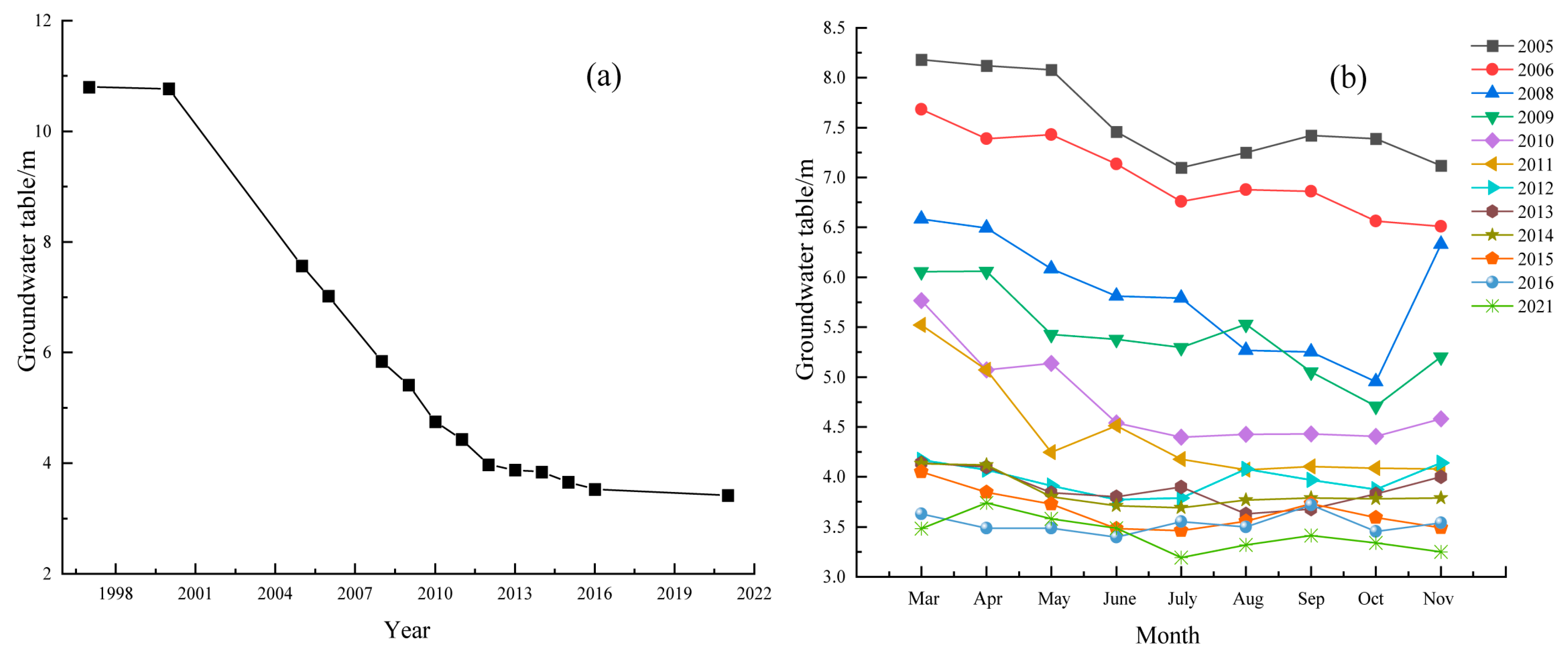
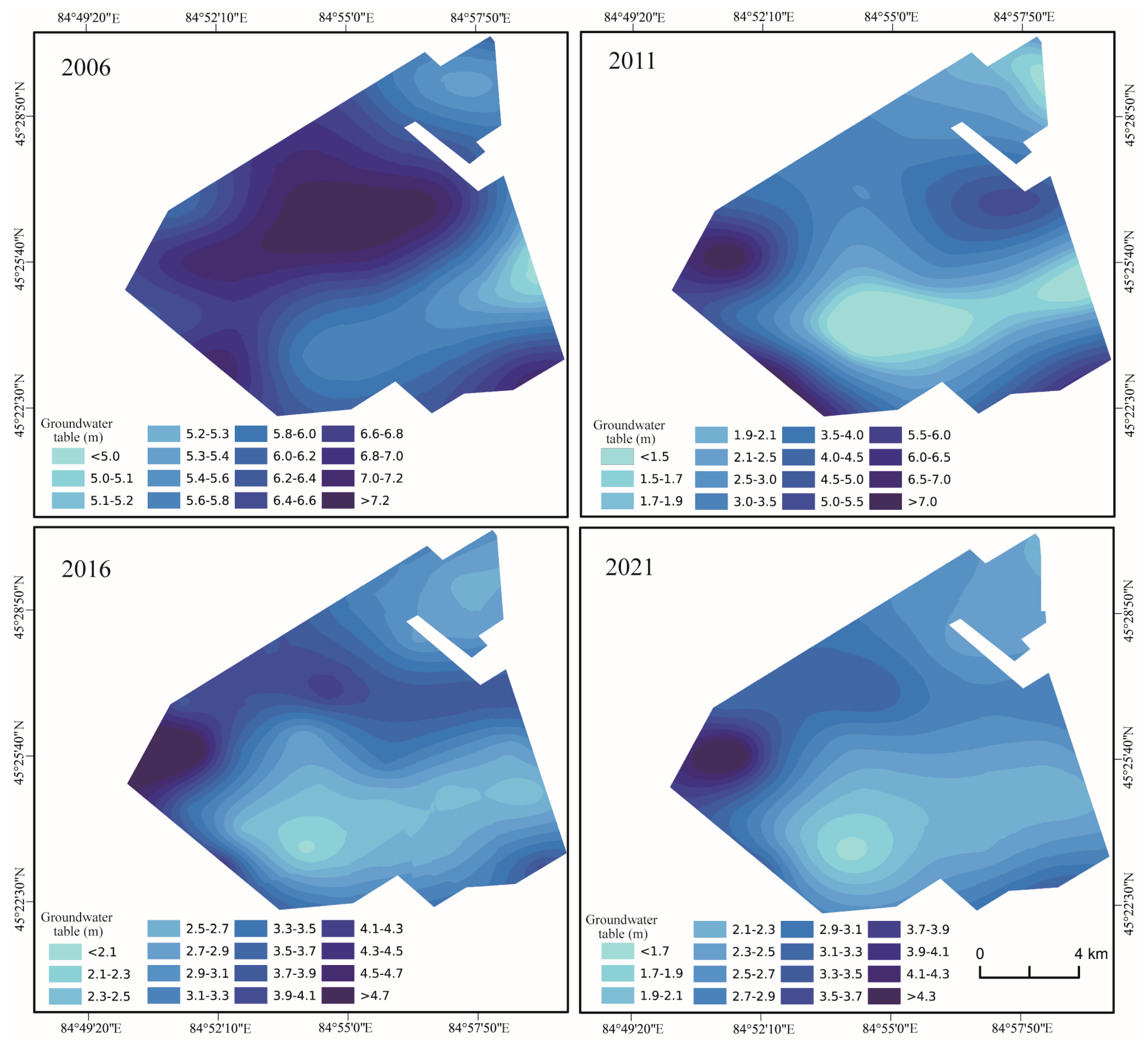
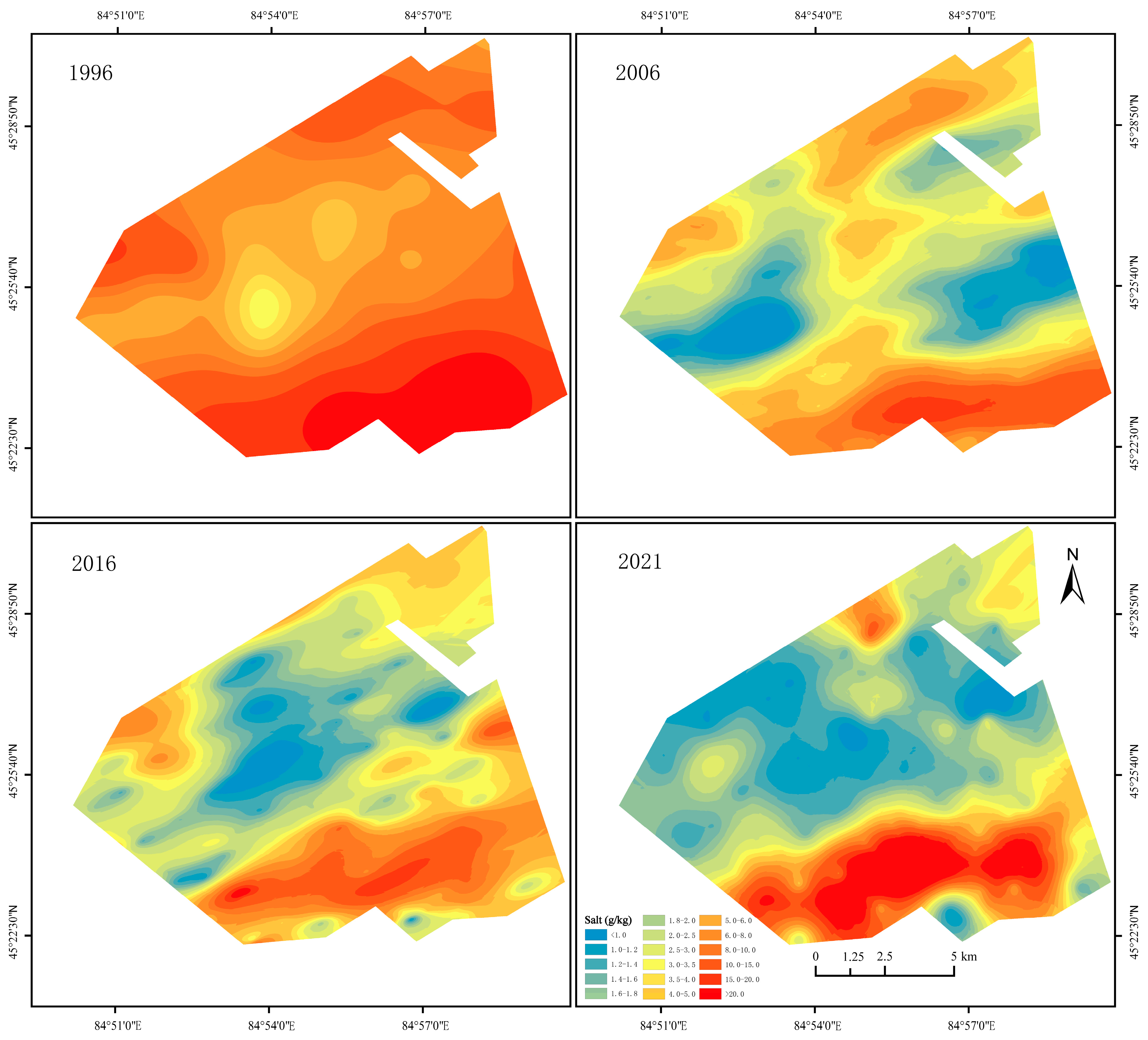
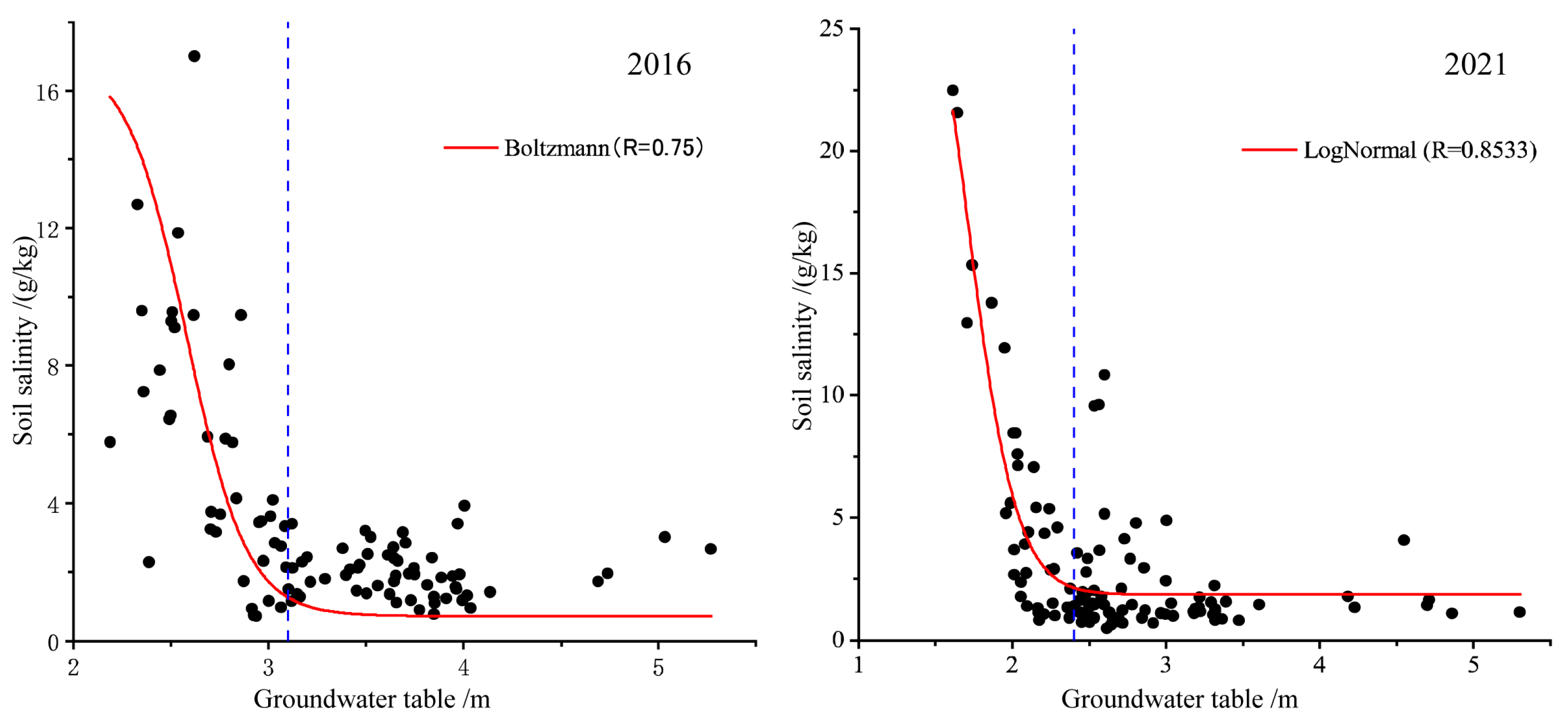
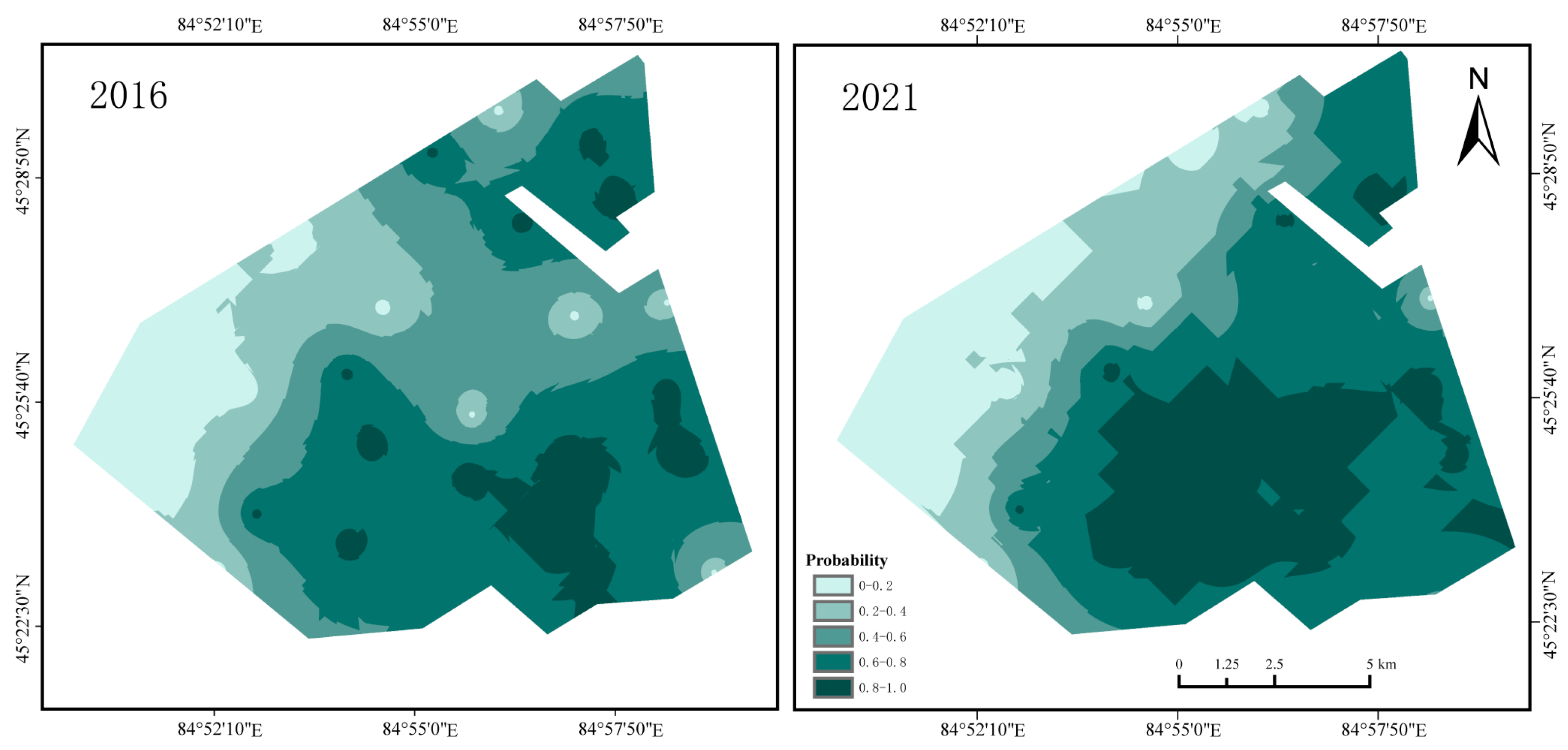
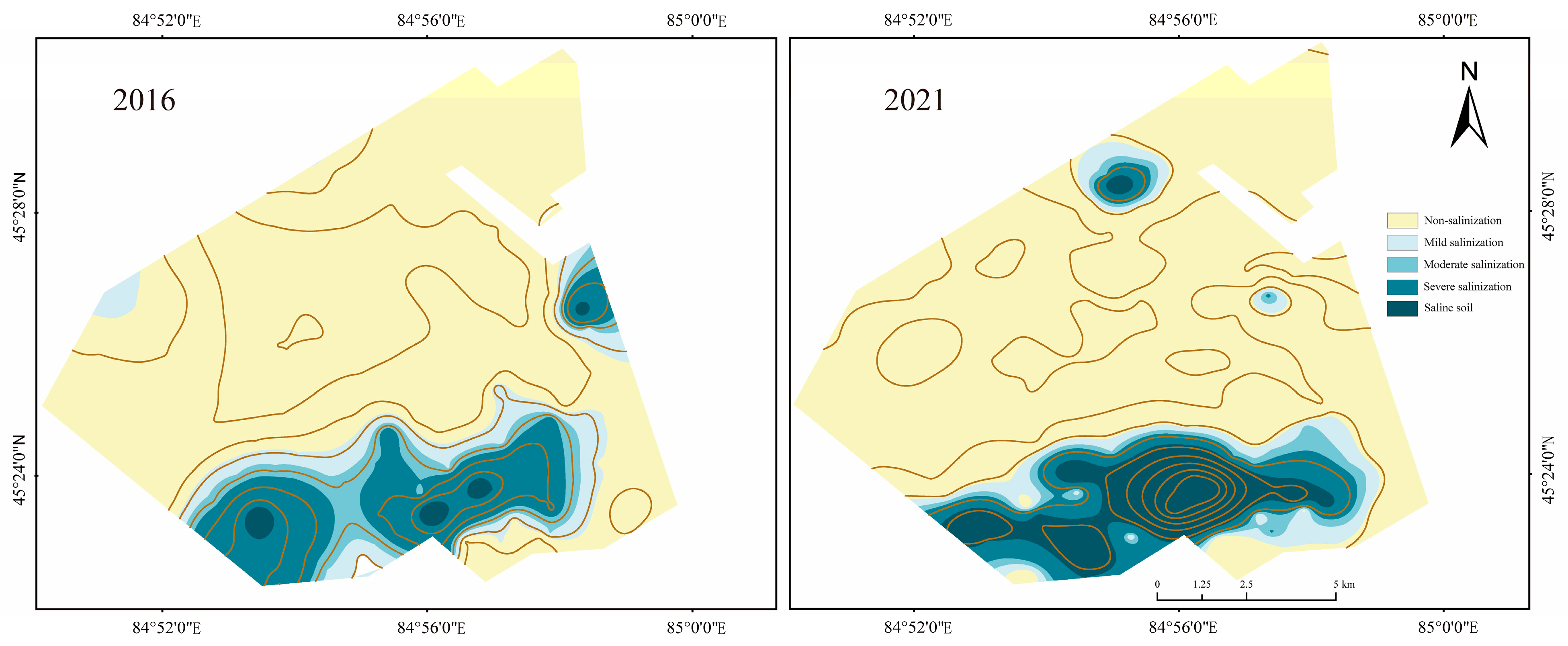
| Year | <2 m | 2–3 m | 3–4 m | 4–5 m | 5–6 m | >6 m | Total (%) |
|---|---|---|---|---|---|---|---|
| 2006 | 0 | 0 | 0 | 0 | 30.85 | 69.15 | 100 |
| 2008 | 0 | 5.99 | 26.96 | 33.19 | 17.87 | 15.99 | 100 |
| 2009 | 0 | 23.75 | 32.32 | 21.52 | 11.57 | 10.84 | 100 |
| 2010 | 18.78 | 28.15 | 24.00 | 18.17 | 6.10 | 4.79 | 100 |
| 2011 | 23.72 | 26.83 | 26.03 | 13.28 | 6.33 | 3.80 | 100 |
| 2012 | 32.41 | 26.60 | 20.39 | 13.91 | 4.50 | 2.20 | 100 |
| 2013 | 27.17 | 36.40 | 30.57 | 4.34 | 1.52 | 0 | 100 |
| 2014 | 25.99 | 33.47 | 29.76 | 9.00 | 1.79 | 0 | 100 |
| 2015 | 22.28 | 54.61 | 19.95 | 3.16 | 0 | 0 | 100 |
| 2016 | 20.00 | 36.62 | 38.40 | 3.60 | 1.38 | 0 | 100 |
| 2021 | 10.84 | 69.03 | 15.57 | 3.57 | 0.99 | 0 | 100 |
| Project | Year | Maximum g/kg | Minimum g/kg | Range g/kg | Mean g/kg | Standard Deviation | Variance % | Skewness |
|---|---|---|---|---|---|---|---|---|
| Soil salinity | 1996 | 56.747 | 0.454 | 56.293 | 14.424 | 11.213 | 77.74 | 1.169 |
| 2006 | 30.800 | 1.400 | 29.400 | 11.418 | 6.052 | 108.00 | 1.488 | |
| 2016 | 73.950 | 0.370 | 73.580 | 5.188 | 7.216 | 139.08 | 6.238 | |
| 2021 | 46.480 | 0.490 | 45.990 | 5.109 | 8.198 | 160.45 | 3.078 |
| Degree of Salinization | 1996 | 2006 | 2016 | 2021 |
|---|---|---|---|---|
| Non-salinization | 0.00 | 47.07 | 49.33 | 64.25 |
| Mild salinization | 20.95 | 36.07 | 30.62 | 13.87 |
| Moderate salinization | 38.83 | 8.44 | 12.61 | 6.59 |
| Severe salinization | 29.51 | 8.43 | 7.35 | 8.02 |
| Saline soil | 10.71 | 0.00 | 0.10 | 7.27 |
Disclaimer/Publisher’s Note: The statements, opinions and data contained in all publications are solely those of the individual author(s) and contributor(s) and not of MDPI and/or the editor(s). MDPI and/or the editor(s) disclaim responsibility for any injury to people or property resulting from any ideas, methods, instructions or products referred to in the content. |
© 2023 by the authors. Licensee MDPI, Basel, Switzerland. This article is an open access article distributed under the terms and conditions of the Creative Commons Attribution (CC BY) license (https://creativecommons.org/licenses/by/4.0/).
Share and Cite
Liu, G.; Tian, C.; Mai, W.; Azeem, A.; Yang, J. Spatial and Temporal Variation in Soil Salinity and Correlation with Groundwater Depth in the Karamay Irrigation District of China. Sustainability 2023, 15, 15680. https://doi.org/10.3390/su152215680
Liu G, Tian C, Mai W, Azeem A, Yang J. Spatial and Temporal Variation in Soil Salinity and Correlation with Groundwater Depth in the Karamay Irrigation District of China. Sustainability. 2023; 15(22):15680. https://doi.org/10.3390/su152215680
Chicago/Turabian StyleLiu, Guohui, Changyan Tian, Wenxuan Mai, Ahmad Azeem, and Jige Yang. 2023. "Spatial and Temporal Variation in Soil Salinity and Correlation with Groundwater Depth in the Karamay Irrigation District of China" Sustainability 15, no. 22: 15680. https://doi.org/10.3390/su152215680
APA StyleLiu, G., Tian, C., Mai, W., Azeem, A., & Yang, J. (2023). Spatial and Temporal Variation in Soil Salinity and Correlation with Groundwater Depth in the Karamay Irrigation District of China. Sustainability, 15(22), 15680. https://doi.org/10.3390/su152215680








